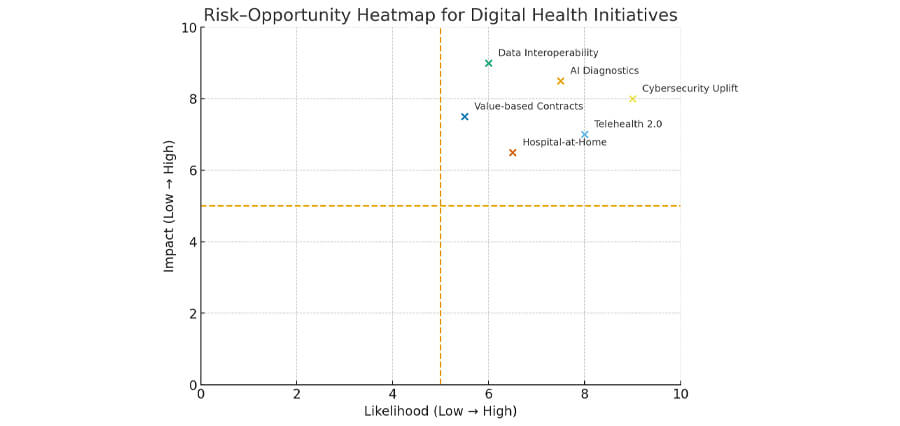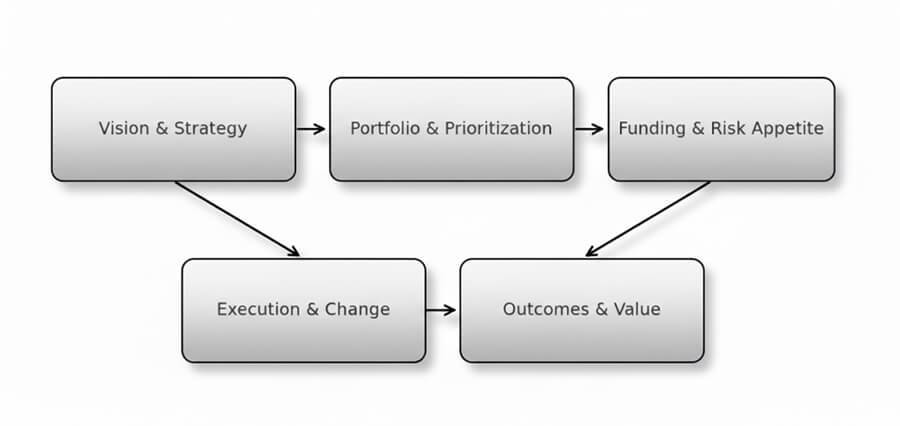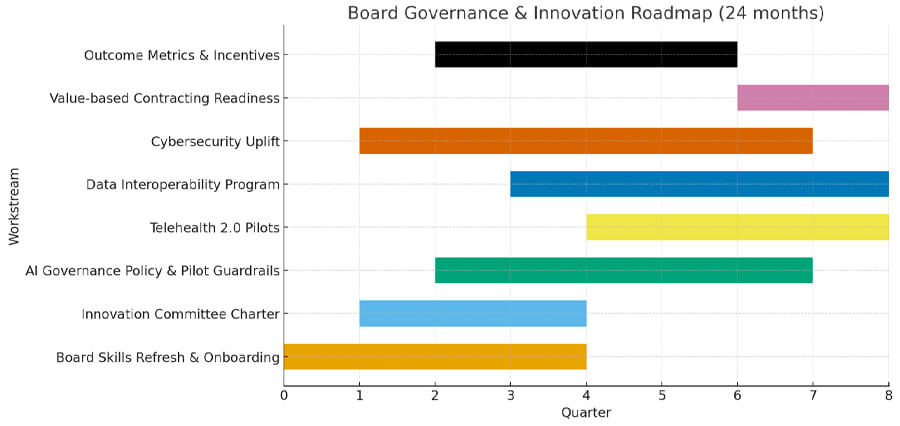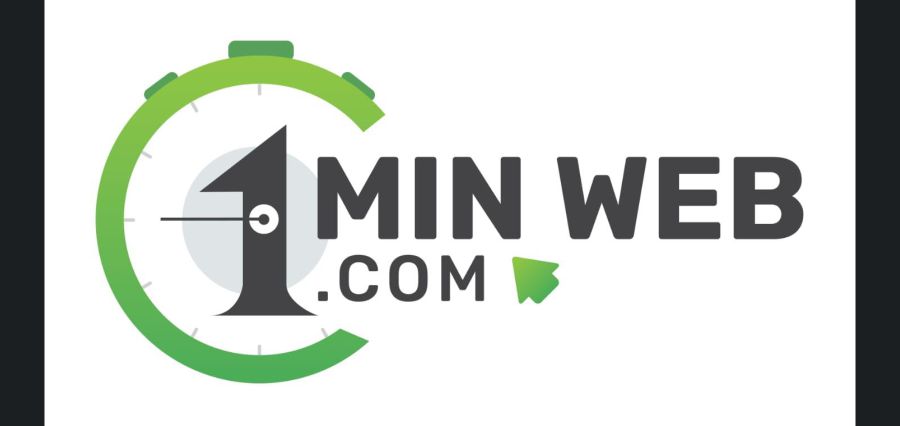Abstract
Healthcare is at a transformative juncture, driven by rapid technological advances, demographic shifts, and new market entrants. In this evolving landscape, boards of healthcare organizations must move beyond traditional oversight and actively champion innovation; proactive board leadership, via strategic adaptation, diversified expertise, and a risk-tolerant mindset, is essential for future success.
Introduction
Healthcare stands at an inflection point: technology and market forces are upending long-standing norms. Giants like Amazon and Google are investing heavily in patient care and health data, while artificial intelligence promises to revolutionize diagnostics and treatment. As one healthcare CEO warns, “Never in my 37 years have I seen the pace and force of change we have experienced in healthcare”. These disruptions, from empowered consumers to new entrants, mean that simply preserving the status quo is no longer safe.
“To thrive in this era, governing boards must embrace innovation as a core responsibility. They should evolve their composition, culture, and oversight to support new technologies and care models. This article examines the forces of compelling innovation in healthcare, analyzes how boards can adapt and explains why active board leadership in innovation will determine healthcare’s future success.”
The Disruptive Forces Shaping Healthcare
Healthcare is undergoing profound transformation that demands innovative leadership. Many systems still rely on “fax machines, manual processes, and outdated workflows,” making them ripe for overhaul. A Deloitte survey found that “accelerated digital transformation” was the top issue for 2025, with about 70% of health executives saying investments in digital tools and platforms will be important. In practice, this means virtual care, data analytics, and AI are rapidly becoming central to healthcare delivery.
Demographic and market pressures compound this. Aging populations and chronic disease burdens strain resources, and a global workforce shortage loom (the WHO estimates a shortfall of 10 million healthcare workers by 2030). At the same time, nontraditional competitors like Amazon, Walmart, and Google are entering healthcare, instigating change through technology and new business models. Patients now expect consumer-grade convenience and value. The combined effect is unprecedented turbulence, as summarized in Figure 1.

Figure 1. Risk–Opportunity Heatmap for digital health initiatives. It helps the board separate high-impact, high-likelihood projects from those to explore cautiously.
Takeaway: In this high-velocity context, healthcare boards confront novel challenges. The next section argues that boards must evolve their governance roles to actively guide innovation and change, not just retrospectively manage risk.
The Evolving Role of Healthcare Boards
Traditionally, boards focus on fiduciary oversight, compliance, and risk management. In today’s landscape, however, experts argue that this mandate must expand. Boards should act in a strategic or generative mode, anticipating trends and shaping direction rather than only reviewing past results. Watson Advisors calls this “future-focused governance,” where boards “balance effective risk mitigation with the ability to spot opportunity, navigate uncertainty, and guide their organizations through transformation”. See Figure 2 for the board’s innovation operating model.

Figure 2. Board Innovation Operating Model. From vision to value: challenge strategy, set risk appetite, allocate funding, monitor outcomes, steward talent and ethics.
This shift is echoed by industry leaders. Healthcare CEO Michael Ugwueke insists that boards “must foster innovative decision-making and solutions.” He argues that boards should encourage executives to experiment and take calculated risks in service of the mission, even allowing for some failure as part of the learning process. In practice, this means boards should not rubber-stamp only safe initiatives; they should actively ask which new ideas might drive better outcomes and authorize pilot projects with appropriate oversight.
Consultancies reinforce this trend. Russell Reynolds Associates finds that governance at academic medical centers will require transformation in the next decade: boards must manage traditional responsibilities alongside innovation and digital strategy. One analysis concludes that future boards will be “smaller, sharper, and more strategic,” with the expertise and foresight to navigate change.
Takeaway: Boards must redefine their success metrics. Effective governance in the modern era means guiding long-term strategy and innovation, not merely curtailing risk. By doing so, boards honor their fiduciary duty in a changing world: they protect the organization’s future viability. The next section examines how boards can develop the right composition and culture to fulfill this expanded role.
Board Composition and Culture for Innovation
Evolving the board’s role requires updating who sits on it and how they think. A board of similar backgrounds and narrow expertise cannot lead breakthrough change. Ugwueke notes that many community hospital boards are still dominated by bankers and lawyers, a legacy of the past, and he urges boards to become competency-based. He recommends conducting intentional skill-gap assessments and recruiting directors with modern expertise. For healthcare boards, this means adding members with backgrounds in technology, data science, or healthcare innovation. Table 1 highlights critical competencies and gaps to close.
Table 1. Board Composition Skills Matrix. Core competencies and indicators for effective innovation governance.
| Key Competence | Why It Matters for Innovation | Evidence / Indicator | Current Presence | Gap |
| Healthcare and Clinical Outcomes | Links innovation to quality and safety | Medical or clinical director on the board | Yes / No | Low/ Medium/ High |
| Data, AI and Interoperability | Ensures the right questions on usage, bias, and privacy | Data/AI expert with healthcare experience | Yes / No | Low/ Medium/ High |
| Cybersecurity | Safeguards trust and business continuity | CISO or dedicated advisor | Yes / No | Low/ Medium/ High |
| Finance and Innovation Portfolio | Enables sound capital allocation and ROI | Former CFO or VC/PE health investor | Yes / No | Low/ Medium/ High |
| Patient & Consumer Experience | Drives digital adoption and access | Patient or CX representative | Yes / No | Low/ Medium/ High |
| Regulatory / Ethics | Ensures compliance, AI
governance, and ESG integrity |
Regulatory or ethics expert | Yes / No | Low/ Medium/ High |
Training and learning culture are equally critical. Even experienced directors must learn new domains. McKinsey reports that after boards undergo immersive technology training, over half made digital transformation into their top agenda item. Directors should demystify emerging technologies (like AI and telehealth) so they can ask informed questions. Watson recommends that future-focused boards allocate time for scenario-planning and reflection on mission and external trends, and that routine agendas be streamlined to allow more time for strategic discussion.
Concrete governance practices can embed this culture. The AMA stresses that “CEO and Board level commitment is important for the successful adoption of AI”. Boards can act on this by formally overseeing AI and digital initiatives: for example, establishing an innovation committee or requiring regular reports on technology strategy. Boards should also define innovation-related success metrics (such as improvements in patient engagement or operational efficiency) and tie them to executive incentives. Table 2 turns these practices into an operational checklist for the board.
Table 2. Innovation Oversight Checklist. Key questions, required evidence, and expected decisions at each meeting.
| KPI | Definition | Target | Cadence | Owner |
| Time-to-Decision | Median time from proposal to board approval | ≤ 2 months | Quarterly | Chair & CEO |
| Mix H1/ H2/ H3 | Incremental / Adjacent / Transformational innovation ratio | 60/ 30/ 10 | Quarterly | CIO / CSO |
| Clinical Outcomes | Three priority outcome indicators | Above benchmark | Quarterly | CMO |
| Digital Adoption | Active patients using the “digital front door” | Positive trend | Monthly | CDO |
| Cyber Posture | Mean Time to Detect / Mean Time to Respond | Decreasing | Monthly | CISO |
| Value-Based Revenue | Share of total revenue under value-based models | Increasing | Quarterly | CFO |
Takeaway: By purposefully recruiting diverse expertise and fostering a continuous-learning environment, boards equip themselves to govern innovation. A well-composed, tech-savvy board can more effectively oversee digital health strategy and set investment priorities. The next section addresses a common objection to this approach and shows why caution alone won’t suffice.
Why Caution Alone Isn’t Enough
Some may argue that boards should stick to core governance and leave innovation to management. From this view, boards risk overstepping by delving into technical details or micromanaging. After all, directors often volunteer for oversight roles, not to become technologists. However, this cautious stance overlooks the risks of inaction. Boards that stay narrowly risk-focused may inadvertently stifle their organizations. Ugwueke warns that boards “protective of the little they have” can impede growth. In a rapidly changing industry, waiting for management to innovate on its own may lead to being outpaced by competitors. In fact, Ugwueke bluntly notes that the days of a “rubber-stamp” board are over. Today’s boards must be knowledgeable enough to know what questions to ask, for example, about market shifts and emerging care models.
Evidence further challenges the “hands-off” view. Studies show that when boards actively engage with quality and strategy, patient outcomes improve. By analogy, boards that engage with innovation can similarly drive better organizational outcomes. Conversely, boards that remain passive risk falling behind. As one consultant warned, healthcare must not wait “for disruptors to skim off the profitable areas”; instead, boards must lead innovation themselves. Takeaway: Governance and innovation are not mutually exclusive. While boards should respect executive expertise, they cannot abdicate strategic foresight. A conservative, reactive board invites stagnation. The evidence and expert consensus indicate that effective boards balance fiduciary diligence with proactive innovation.
Conclusion: Boards as Architects of Healthcare’s Future
Healthcare’s future hinges on innovation, from AI-enabled medicine to novel care models, and boards will largely determine whether their organizations thrive or falter. A board that embraces change sets the tone: it signals to the entire organization that pursuing breakthroughs (even with some risk) is a priority. For example, boards that prioritized digital transformation during the COVID-19 pandemic enabled rapid adoption of telehealth and data analytics, improving access and efficiency. By contrast, a complacent board signals that change is unwelcome, risking stagnation and loss of market share.
This article has argued that board leadership must evolve: boards should redefine their role to include active strategy-setting for innovation, recruit relevant expertise, and embed innovation-oriented governance processes. These steps are not optional; they are necessary adaptations. The evidence is clear that technology-driven change is accelerating in healthcare, and forward-thinking boards correlate with better outcomes.
So what? Board chairs and CEOs should act now. Figure 3 offers a 24-month roadmap from diagnosis to execution.

Figure 3. Governance and innovation roadmap for the board. Sequenced work on skills, policy, programs, and metrics.
Begin by auditing the board’s composition and skills: identify gaps in technology, data, and innovation experience and recruit to fill them. Redesign board charters to include innovation metrics or committees and allocate meeting time for scenario planning about digital health trends. Encourage continuous learning through workshops and peer networks. Most importantly, cultivate the mindset that innovation aligns with the organization’s mission, it is paramount to delivering high-quality, sustainable care.
By leading decisively, boards can transform healthcare organizations into agile innovators rather than obsolete incumbents. The future of healthcare depends on it.
References
American Medical Association. (n.d.). Governance for augmented intelligence: Establish a governance framework to implement, manage, and scale AI solutions. AMA STEPS Forward. https://edhub.ama-assn.org/steps-forward/module/2833560
Eames, S., & Brooks, S. (2025, September 25). Designing the board of the future: Governance innovation for academic medical centers. Russell Reynolds Associates. https://www.russellreynolds.com/en/insights/articles/designing-the- board-of-the-future
Huber, C., Sukharevsky, A., & Zemmel, R. (2021, June 21). How boards can help digital transformations. McKinsey & Company. https://www.mckinsey.com/capabilities/mckinsey-digital/our-insights/how-boards-can-help-digital- transformations
Siegel, S., Rekhraj, K., Sandomirsky, D., Ganhão, F. P., Teuber, I., Fransen, M., & Särkkä-Hietala, M. (2025, January 29). 2025 global health care outlook: Survey highlights health system leaders’ plans to focus on efficiency, productivity, and patient engagement this year. Deloitte Insights. https://www.deloitte.com/us/en/insights/industry/health-care/2025-global-health-care-executive-outlook.html
Ugwueke, M. O. (2024, May 19). Disruptive change calls for bold governance. Healthcare Executive (ACHE blog). https://www.ache.org/blog/2024/disruptive-change-calls-for-bold-governance
Watson Advisors Inc. (2025, May 13). Beyond today: Future-focused governance in healthcare. Watson Advisors Inc. https://www.watsoninc.ca/future-focused-governance-healthcare-boards
About the Author
Antonio Miranda
CEO & Board Advisor
Antonio Miranda is a CEO and Board Advisor who turns frontier innovation into durable, responsible growth. He has led transformations in global companies and scale-ups, improving revenue quality, operating discipline, and ESG impact. At Eco Lab he launched biodegradable product lines and built governance and reporting aligned with CSRD.
Previously he drove strategic shifts at Nokia Middle East and Unisys, founded and scaled Logica in Italy, and at Nexi advanced instant payments, open banking, and PagoPA while advising boards on deals, risk, and technology strategy.
Antonio holds executive certificates in Board Effectiveness and Corporate Governance, M&A Finance, Double Materiality Assessment, CSRD Gap Analysis, Private Equity and Venture Capital, AI-driven Digital Transformation, and Innovation Management from SDA Bocconi, ESSEC, and LIUC business schools. He earned dual MSc degrees in Electronic Engineering and Software Engineering, and an Executive MBA (POLIMI GSoM) with electives in Strategy, M&A, and Digital Transformation.
His board philosophy blends sharp strategic challenge, disciplined capital allocation, and long-term stewardship.
+39 3400887035
antonio1.miranda@gsom.polimi.it
linkedin.com/in/antoniomiranda
Disclaimer –
This article is a work of original content created for public relations and informational purposes only. It may be published across multiple digital platforms with the full knowledge and consent of the author/publisher. All images, logos, and referenced names are the property of their respective owners and used here solely for illustrative or informational purposes. Unauthorized reproduction, distribution, or modification of this article without prior written permission from the original publisher is strictly prohibited. Any resemblance to other content is purely coincidental or used under fair use policy with proper attribution.
















